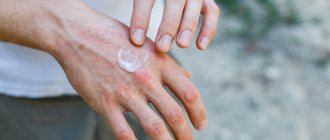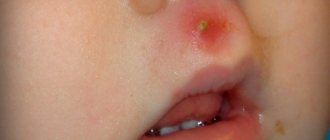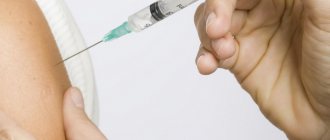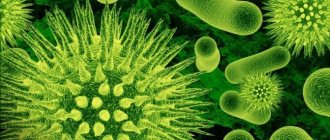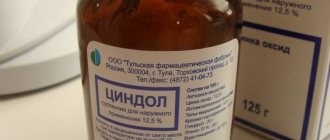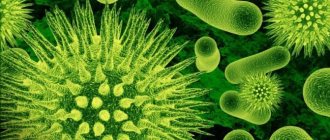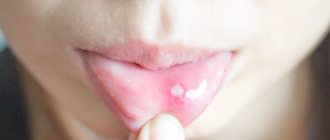Chickenpox - in common parlance, chickenpox is considered more a childhood than an adult disease, which you need to get over once and forget forever, as immunity to this disease is developed. Parents whose children have not yet been ill should be aware of this disease in order to provide the sick child with proper care.
The main sign by which chickenpox is recognized is blisters filled with clear liquid. The rash usually begins from the lower extremities, and within a few hours moves to the top of the head. Most often the disease is accompanied by high fever. It must be remembered that the bubbles that appear on the child’s skin should under no circumstances be squeezed out - scars may remain. Chickenpox is not always accompanied by large rashes; one patient may have from 10 to 50 abscesses, while another child may be covered with them from head to toe. The rash covers not only the skin, but can also form on the mucous membrane of the eyes, on the genitals and even in the mouth. The incubation period for chickenpox is 1 to 3 weeks and is transmitted by airborne droplets over a distance of up to 100 meters. This means that if your child, who was not sick, was in the same room with a chickenpox carrier, know that yours is next.
Chickenpox can be diagnosed by symptoms, without tests or examinations. A child with chickenpox needs home treatment. During the period of rashes, baths should be avoided. Nowadays, just like many decades ago, bubbles are smeared with brilliant green for the purpose of disinfection and drying. As a rule, children from 2 years old experience discomfort on the skin, accompanied by burning and itching. To alleviate the condition, the child is given allergy medications that help reduce itching. Make sure that the child does not scratch the abscesses, this will eliminate the possibility of infection under the skin. In some cases, when an infection occurs, children are prescribed an antibiotic that fights bacteria, but does not affect the course of chickenpox, since it is not effective for viral infections.
Prevention and treatment of chickenpox in children
In recent years, a vaccine has become available that prevents chickenpox infection. The vaccination is effective even after contact with a sick person, the main thing is to have it done within 72 hours. Children are vaccinated against chickenpox from 1 year of age. Immunity lasts for up to 20 years.
It is worth remembering that any disease must be diagnosed correctly and on time. Doctors at our clinic will help you understand the disease and prescribe effective treatment for chickenpox in children . You can make an appointment on this page.
Chickenpox in a child: a reminder for parents
Chickenpox is a viral disease caused by one of the varieties of the herpes virus, namely the varicella-zoster virus. This virus enters a child’s body through airborne droplets – that is, a child can become infected from a sick child. Moreover, patients with chickenpox are contagious in the active phase of the pathology, which occurs two days before the appearance of the rash.
Chickenpox is the popular name for the disease. In medical practice, the pathology is called chickenpox. This disease has characteristic signs and a mild course in childhood, so if a child has had chickenpox, this is good, because then he develops immunity. If a person did not get this disease in childhood, he can become infected with the virus in adulthood, but in this case the disease will be much more severe, and, possibly, severe complications will even develop against its background. That's why doctors say that having chickenpox as a child is normal and even beneficial.
PoxClean for chickenpox – will relieve itching and promote recovery
There is no doubt that green stuff is a great friend of children. I broke my knee - brilliant, scratched - brilliant. The medicine is truly multifunctional. But it was not developed specifically for the treatment of chickenpox. Meanwhile, a new unique remedy for quickly getting rid of the symptoms of chickenpox has appeared on the Russian market - PoxClean.
This natural medical cooling hydrogel was specifically created by scientists to combat chickenpox . It is offered by the Russian “daughter” of the famous and respectable Swiss company PharmaVal SA - Pharmaval LLC.
The remedy for chicken pox - PoxClean has no color (children with polka dots are abolished!) and can significantly alleviate the child’s condition.
Symptoms
The main symptoms of chickenpox are typical. These include:
- increase in body temperature to subfebrile levels (less often to febrile);
- the appearance of papulovesicular rashes throughout the body;
- symptoms of general malaise (weakness, drowsiness, etc.).
Symptoms appear after the incubation period has passed, which usually lasts 5-7 days, but can sometimes last two weeks. The rashes characteristic of this disease appear first on the face and then spread throughout the body - appearing on the arms, chest and back, and lower extremities.
At first, the rashes appear as small blisters that itch and itch. Then the bubbles burst and a weeping surface forms underneath. At the final stage, the blisters become covered with a crust, which should never be torn off, as scars may remain.
PoxClean – a protective barrier against bacteria
Just like kids, PoxClean will also help adults who are unlucky enough to contract a childhood disease. Let us repeat: since chickenpox is difficult for adults to tolerate, the doctor will most likely prescribe more serious treatment than for children. But at the same time, PoxClean will be an excellent addition to relieve the symptoms of chickenpox. It will alleviate the condition: it will help reduce itching, stop the spread of bacteria, and speed up the healing of affected skin areas.
PoxClean is very comfortable to use. Due to its light texture, when applied it does not create friction (and therefore does not damage the bubbles), does not cause any burning sensation, but, on the contrary, only pleasant sensations.
Treatment
If pathology is diagnosed, then treatment of chickenpox in children should be symptomatic. Young patients are given antipyretics if the temperature exceeds 38.5. Medicines that reduce itching are also prescribed, for example, antihistamines such as diazolin, suprastin and some others (as prescribed by a doctor).
In addition, the blisters are lubricated with a solution of brilliant green, due to which they dry out, itch less and heal faster. It would be correct to use drugs that enhance immunity to treat chickenpox. But in adult patients, chickenpox, a type of herpes virus, is treated with Acyclovir.
How to treat scars after chickenpox?
After recovery, scars and pockmarks will not remain, but only if you followed all the doctor’s recommendations and treated the wounds with an antiseptic. If traces of chickenpox are still present, you can get rid of them in different ways. It can be:
- salon treatments;
- creams, gels or ointments;
- ethnoscience.
The choice of a particular procedure depends on the size of the scars or pockmarks, their number, the desired speed of effect and, of course, the presence of contraindications.
Let's consider each method of getting rid of scars after chickenpox in more detail.
Salon treatments
As a rule, this method is chosen in the case of treating deep mature pockmarks in an adult. For children, many procedures are more likely to harm than correct the situation, so they usually try not to touch very noticeable scars on a child.
Salon treatments for scars include:
- Peeling . Treatment of leather with chemical acids. The rehabilitation period after the procedure lasts from a week to a month. During this time, you need to carefully monitor your skin, avoid sunlight, dust, and minor damage.
- Grinding . Laser removal of damaged top layer of skin. Does not require preliminary preparation; it acts in a targeted manner without affecting healthy tissue. Small scars can be removed in one session, but larger ones will require several procedures. Laser resurfacing is contraindicated for pregnant, breastfeeding women and those who had peeling less than 2 weeks before the procedure.
- Microdermabrasion . Removal of the top layer of skin with microcrystals. It will help with small scars; large scars and deep pockmarks will be made less noticeable. Aluminum dioxide particles under pressure penetrate into the deep layers of the skin, and the vacuum pulls them out along with dead cells. This process is traumatic and requires long-term restoration of the skin.
- Wrap . The most harmless of the listed methods: smoothing the skin, evening out the overall tone and smoothing out traces of chickenpox. A medicinal substance is applied to previously cleansed skin, wrapped in film and covered with a thermal blanket. After the session, the product does not need to be washed off.
- Physiotherapy: electrophoresis, phonophoresis . Transfer of useful substances deep into the damaged area of the epidermis using ultrasound (with phonophoresis) or electricity (with electrophoresis). Can be used as a prophylaxis against scars immediately after an exacerbation of chickenpox.
- Injections . Used when there are large depressions on the face. Hyaluronic acid or various cocktails are injected under the skin. They fill the pockmark, making it convex - the surface of the skin is leveled. Over time, the drug is absorbed and pockmarks appear again: the injection should be repeated every six months to a year. However, the injections will not have any effect if you treat old scars.
Before starting any cosmetic procedure, be sure to consult your doctor about contraindications and its necessity in your individual case.
Find out which method of correcting scars and stretch marks is optimal for you!
doctor Svetlana Viktorovna Ogorodnikova.
doctor
Creams, gels, ointments
Applications of cream, gel or ointment for scars do not create such discomfort as any of the salon procedures, and they can be used by children.
It is worth remembering that anti-scar cosmetics should be applied only to an existing scar, but not to an open wound. To remove the consequences of chickenpox, he usually recommends the following remedies:
- Medgel;
- Bepanten;
- Sledotsid;
- Kelofibrase;
- Keratan;
- Zinc ointment;
- Fermenkol;
- Contractubex;
- Mederma;
- Methyluracil;
- Dermalix;
- Zeraderm Ultra.
Some of them give results faster, while others are used for six months or more before the pockmark disappears. They are chosen based on the age of the scar, price, personal contraindications and recommendations of the attending physician.
ethnoscience
For lovers of everything natural, “grandmother’s” recipes are suitable, which anyone can prepare at home:
- Lubricate your face with a slice of cucumber;
- Apply simmered onion over low heat to the pock marks (cook for about 15 minutes);
- For 1 teaspoon of cocoa butter, dilute 3 drops of sandalwood and tea tree essential oil. Rub into scars or pockmarks using massage movements.
- Pour boiling water over 1 tablespoon of dried marshmallow and leave for 8 hours. Wipe the skin with the solution up to 5 times a day.
- Finely ground oatmeal. Pour boiling water over and cool. Apply the paste for 30 minutes to adults and children.
The advantages of traditional medicine are that most recipes, with rare exceptions, are suitable for both adults and children. However, the visible effect will not appear immediately - you will have to be patient for six months, a year.
Causes and features of pathogen transmission
The disease spreads quickly and easily indoors, since the causative agent, the herpes virus, can be transmitted through coughing, sneezing, i.e. by air. A greater number of chickenpox cases occur in preschool children. Children staying in the same group room of a kindergarten get sick faster, although the virus is able to penetrate with air flow into neighboring rooms. Less commonly, the pathogen is transmitted through toys or third parties, since it is unstable in the external environment.
The peak of the disease occurs in spring/autumn, together with the peak of colds. The pathogen is transmitted by the bloodstream to the epithelial layers of the skin, where it begins to actively multiply. There are subjective signs of the onset of the disease: irritability, tearfulness of the child, the appearance of a common rash similar to hives. Due to the mobility of the virus in the blood, internal organs may be affected. The mucous membrane is an excellent “soil” for the virus; as a result, small hemorrhages form at the site of the papules. Immunity after the disease is stable (except for early infection by the virus).
Adults who did not have chickenpox as children may not get sick at all if they have a strong immune system. But when infected, adults become seriously ill, with a high rise in body temperature, and subsequently scars and visible dents form in place of the papules.
Features of the pathogen:
- papular fluid contains DNA;
- the virus is deactivated at a temperature of 45 to 50 degrees. It is enough to soak the patient’s clothes in hot water for half an hour to destroy the virus. Disinfectants should not be used when processing children's clothing; they can cause increased itching and rashes;
- the virus is not destroyed by freezing; after defrosting, the pathogen is still active. But it does not tolerate sunlight well, so when disinfecting a room, you can use ultraviolet lamps;
- the pathogen can be transmitted through the placenta from a sick pregnant woman to the fetus, as a result of which there may be damage to the fetus that does not threaten its life;
- in exceptional cases, chickenpox is contracted twice, if the first time occurred before the age of one year, when the child’s own immunity is not yet “working.”
Symptoms of the disease
On average, up to two weeks after the virus enters the body, the child feels normal. Then the body temperature rises sharply and quickly, and at the same time rashes appear on the head under the hair, cheeks, near the lips, and on the mucous membranes of the mouth. Due to the rash, the child becomes restless, the unpleasant tingling sensations in the papules a little later turn into severe itching, and the baby’s condition worsens.
Development of chickenpox
Initially, only a rash is visible on the skin, similar in appearance to miliaria. Then characteristic small spots become visible, in place of which bubbles with transparent contents - vesicles - form. There is always a small border around the bubble - a hyperemic halo. After a few hours, the liquid in the bubble becomes cloudy, and even later the bubble bursts and the liquid begins to flow out of it. If the vesicle is not touched, then after two or three days it begins to dry out. A dense crust forms from the center to the edges of the bubble, and after the crust has completely dried, the skin remains pink, but without scars, smooth to the touch. If a child actively scratches the rash, indentations may form, as after a BCG vaccination.
The bubbles do not appear all at once, but several days apart, so quarantine for chickenpox lasts up to three weeks. During this time, rashes in different stages of development may be visible on the skin - from spots to crusts. To treat chickenpox, doctors still recommend using a solution of brilliant green, which disinfects and dries watery blisters. Yes, it is ugly, the child will walk around with spots, but it is effective in preventing suppuration from scratching and the rapid healing of wounds.
If the course of the disease is severe, with a large amount of rash, the child is prescribed medications that lower the temperature and antihistamines. Acyclovir is effective only if used in a timely manner; if the disease is protracted, it should not be used. Sometimes doctors prescribe immunostimulants, for example, cycloferon liniment - it successfully replaces brilliant green. The drug facilitates the course of the disease and prevents the development of purulent infection when the blisters are scratched.
Prevention of scars after chickenpox
To reduce the likelihood of pockmarks or pits appearing, it is not enough to only monitor the condition of the crust and bubbles. Hygiene is also important.
It is recommended to change bed linen once a day: pillowcase, sheet, duvet cover - all of this is in contact with the patient’s face and body. The infection persists in the underwear, and if you use it for a long time, you can add the same virus to the unhealed wound that the body is trying to fight.
And your nails should also be clean: if you scratch the wound until it bleeds, in addition to the virus, microbes from under the nails can be introduced into the epidermis. To avoid scars after chickenpox, babies even wear mittens.
The rash must be disinfected every day with special solutions, ointment or regular brilliant green. And if chickenpox is particularly severe, doctors prescribe antiviral drugs.
In addition to the antibacterial effect, all ointments used for chickenpox cool the inflamed area and relieve itching.
Antiviral drugs
A profuse rash with severe or moderate chickenpox can be lubricated with:
- Acyclovir (Zovirax).
This drug directly affects the causative agent of chickenpox, providing an antiherpetic effect. Acyclovir accelerates the healing of the rash and reduces the inflammatory process in the skin. - Viferon.
To treat chickenpox rash, you can use white gel or yellow ointment. This drug has antiviral and immunomodulatory effects due to the presence of interferon alpha-2B. - Oxolinic ointment (3%).
The product has a local effect, inhibiting the reproduction process of the herpes virus.
Folk remedies for chicken rash
Traditional medicine is often used for chickenpox. There are various prescription medications for treating the disease.
Facilities:
- You can strengthen your immune system by drinking honey and lemon every day.
- Rubbing with a soda solution (a spoonful of soda in a glass of water) will help cope with severe itching.
- Blueberries will help you quickly cope with the disease. They are consumed in pure form or drunk with blueberry juice.
- Drinking a tablespoon of celery juice three times a day will help you cope with the disease faster.
- To reduce inflammation and relieve itching, take baths with herbal decoctions - chamomile, nettle, yarrow.
On the Internet you can find various traditional medicine recipes for the treatment of chickenpox. This treatment should be used with caution to avoid allergic reactions.
Possible complications
- Aesthetic skin problems. After pockmarks, there may be blisters on the skin, small potholes, like after acne, etc., which cannot always be eliminated later.
- Pneumonia. Most often this happens to children whose immunity is significantly weakened.
- Brain damage (so-called “chickenpox encephalitis”). A rare but possible phenomenon associated with chickenpox, in which certain areas of the brain are temporarily “attacked.” Which, accordingly, causes disorder of behavior and facial expressions, tremors and loss of coordination. However, with proper therapy it can be successfully treated.
- Reye's syndrome (“acute hepatic encephalopathy”). This is a very rare, but at the same time very serious disease, which, according to some medical studies, occurs due to the use of drugs based on acetylsalicylic acid (for example, aspirin) in the treatment of chickenpox.
It should be remembered that most complications with chickenpox (as with other viral infections) occur due to dehydration. Give your child plenty of water and the risk of any complications will be significantly reduced.
